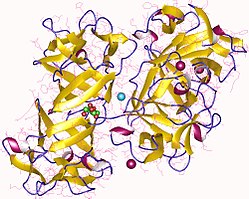Fascin
| Fascin | ||
|---|---|---|

|
||
| Human fascin | ||
| other names |
|
|
| Properties of human protein | ||
| Identifier | ||
| Gene name | FSCN | |
| External IDs | ||
Fascin is a small, very compact protein with a weight of 55 to 58 kilodaltons that bundles actin filaments in such a way that they are rigidly and parallelly connected at 10 nm apart. Its two different actin binding sites are on the same polypeptide . Actin binding is regulated by phosphorylation .
Occurrence and forms
Fascin was originally isolated as one of the first proteins that can bundle actin in sea urchin eggs in 1982, but it is also found in Drosophila and vertebrates.
There are three different forms of fascin, all of which are encoded by different genes:
- Fascin 1 (FSCN 1) , which occurs in nerve cells and in varying amounts in other cells
- Fascin 2 (FSCN 2) , which in the retina expressed will, and
- Fascin 3 (FSCN 3) , which is only found in the testicles.
function
Fascin is mainly localized in actin-rich cell protrusions, the filopodia , where it serves to stabilize actin filaments with little dissociation by packing them into tight bundles. This increases the mechanical resistance of the filaments. The solidification of the F-actin network results in a sudden break in the elasticity of the fibers and a subsequent slow decrease, in contrast to alpha-actinin 3 , which increases the elasticity. The rate at which F-actin solidifies in the presence of fascin is not linearly dependent on the concentration of fascin. Studies have shown that this could be due, on the one hand, to the fact that the bundling and linking of actin competes with the further branching of actin filaments and bundles, and on the other hand to the fact that a delayed amalgamation of actin with increased microheterogeneity also competes. Further research has shown Fascin to play a key role in the branching of actin filaments. The branching of F-actin in turn promotes the formation of a network between the filaments, which inhibits the mobility of the individual F-actin fibers.
Fascin is regulated by protein kinase C through phosphorylation of serine 39 .
Clinical reference
Fascin is expressed to different degrees in all human tissues, but expression appears to be greatly increased in tumor cells and to be related to metastasis , especially of carcinomas of the epithelial cells . An increase in fascin in cancer cells could give them further motility and thus opportunities for invasion into other tissues. How exactly this works is not known, but studies show that filopodia are involved in cell motility, and that fascin stabilizes actin in invasive cell processes ( invadopodia ). Accordingly, Fascin can be used as a marker for a tumor disease and can be used to create a prognosis; however, it is not specific to cancer. Other diseases such as infection with the Epstein-Barr virus also result in the appearance of fascin in certain cells (here: B lymphocytes ).
Individual evidence
- ^ Fascin , Lexicon of Biology, Spectrum Academic Publishing House, 1999 Heidelberg.
- ↑ J. Bryan, R. Edwards, P. Matsudaira, J. Otto and J. Wulfkuhle: Fascin, an echinoid actin-bundling protein, is a homolog of the Drosophila singed gene product . In: Proceedings of the National Academy of Sciences . 90, No. 19, October 1993, pp. 9115-9119. PMC 47512 (free full text).
- ^ Robert A. Edwards and Joseph Bryan: Fascins, a family of actin bundling proteins . In: Cell Motility and the Cytoskeleton . 32, No. 1, February 2005, pp. 1-9. doi : 10.1002 / cm.970320102 . PMID 8674129 .
- ↑ http://omim.org/entry/602689
- ↑ Shengyu Yang, Fang-Ke Huang, Jianyun Huang, Shuai Chen, Jean Jakoncic, Alejandra Leo-Macias, Ruben Diaz-Avalos, Lin Chen, J. Jillian Zhang and Xin-Yun Huang: Molecular Mechanism of Fascin Function in Filopodial Formation . In: The Journal of Biological Chemistry . 288, No. 1, January 2014, pp. 274–284. doi : 10.1074 / jbc.M112.427971 . PMC 3537022 (free full text).
- ↑ N. Kureishy, V. Sapountzi, S. Prag, N. Anilkumar and JC Adams: Fascins, and their roles in cell structure and function . In: BioEssays: News and reviews in molecular, cellular and developmental biology . 24, No. 4, April 2002, pp. 350-361. PMID 11948621 .
- ^ Y. Tseng, E. Fedorov, JM McCaffery, SC Almo and D. Wirtz: Micromechanics and infrastructure of actin filament networks crosslinked by human fascin: a comparison with alpha-actinin . In: Journal of Molecular Biology . 10, No. 2, July 2001, pp. 351-366. PMID 11428894 .
- ^ Ang Li, John C. Dawson, Manuel Forero-Vargas, Heather J. Spence, Xinzi Yu, Ireen König, Kurt Anderson and Laura M. Machesky: The actin bundling protein fascin stabilizes actin in invadopodia and potentiates protrusive invasion . In: Curriculum Biology . 20, No. 4, February 2010, pp. 339-345. doi : 10.1016 / j.cub.2009.12.035 . PMC 3163294 (free full text).
- ↑
- ↑ Caroline F. Mohr, Martina Kalmer, Christine Gross, Melanie C. Mann, Kai R. Sterz, Arnd Kieser, Bernhard Fleckenstein and Andrea K. Kress: The tumor marker Fascin is induced by the Epstein-Barr virus-encoded oncoprotein LMP1 via NF-κB in lymphocytes and contributes to their invasive migration . In: Cell Communication and Signaling . 12, No. 46, July 2014. doi : 10.1186 / s12964-014-0046-x . PMID 25105941 . PMC 4222691 (free full text).